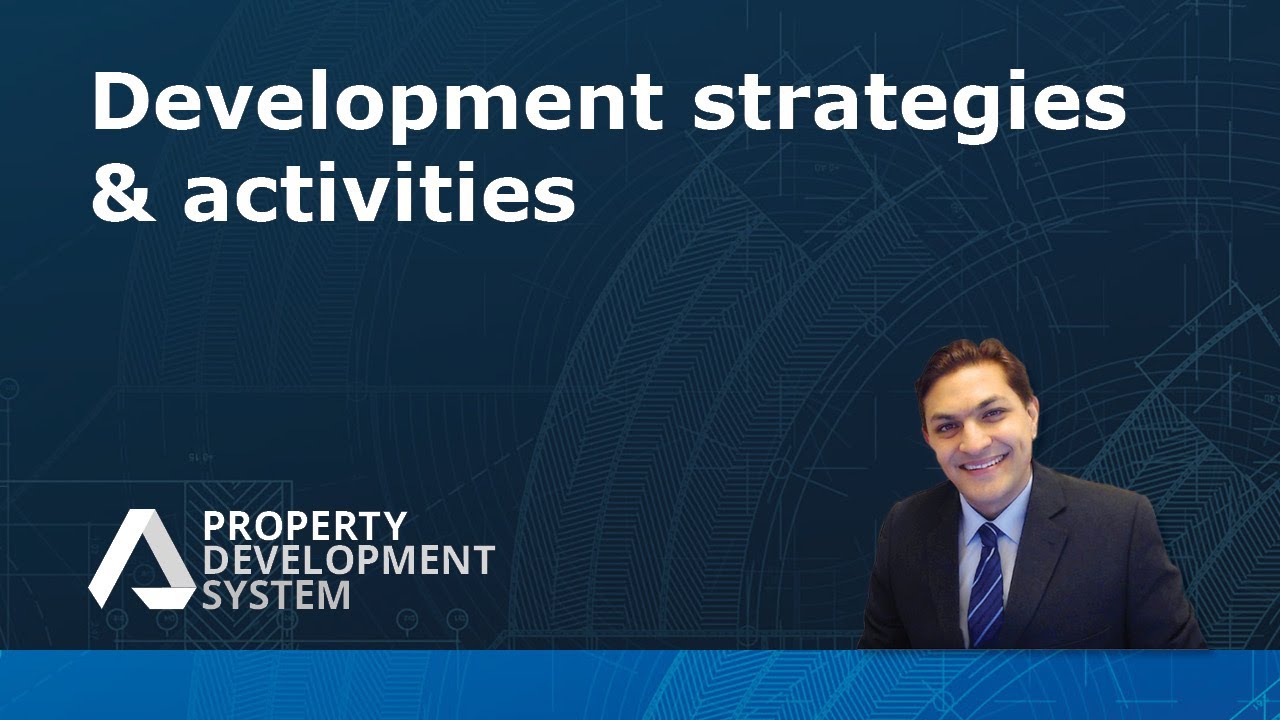Development Strategies & Activities
Here is a comprehensive overview of the property development process, emphasising the entrepreneurial nature of real estate developers and the multifaceted steps involved in property development. The analysis spans from initial land banking to the eventual redevelopment or renovation of properties. Key highlights include:
Entrepreneurship
Property developers are described as entrepreneurs who must be creative and innovative, understanding how various pieces of a project fit together and work in unison.
Process Steps
The video outlines the property development cycle, including land banking, land packaging, land development, building operations and management, and renovation or redevelopment.
Activities
Essential activities for successful property development are listed, such as market analysis, due diligence, financial feasibility, land finance, acquiring land, addressing environmental issues, obtaining permits, and marketing.
Risk Management
A significant focus is placed on risk and uncertainty management, emphasizing how each step in the development process helps reduce risks and uncertainties.
Insights based on numbers
- The property development cycle is detailed through six stages, highlighting the transition from raw land acquisition to redevelopment.
- Ten essential activities required for property development are mentioned, illustrating the complexity and the need for thorough planning and execution.
Frequently Asked Questions
How do property developers manage risks and uncertainties throughout the development process?
Proactive Planning
Developers begin with thorough market analysis and due diligence to understand potential risks before they arise.
Strategic Steps
The development process is divided into clear stages, such as land banking, land packaging, land development, and so on. Each stage is focused on adding value while mitigating specific risks associated with that phase.
Permit and Approval Process
Obtaining development approvals, planning permits, and ensuring environmental compliance are crucial steps that help in identifying and mitigating legal and regulatory risks.
Incremental Development
The process is incremental; as developers move from one step to the next, they reassess risks based on updated information and take measures to address them, ensuring that risk levels diminish over time.
Capital Management
The video highlights that with each step, additional capital may be required, but the cost of this capital decreases as the value of the project increases, thereby reducing financial risk.
What are the critical steps in transforming raw land into developed properties?
Land Banking
This initial step involves acquiring undeveloped or raw land anticipated to become attractive for future development due to general market trends.
Land Packaging
After acquiring the land, developers enhance its value through obtaining development approvals, planning permits (DA), and other paper infrastructure improvements like zoning changes or environmental studies. This step is crucial for making the land more attractive for development or sale.
Land Development
Here, developers work on improving the land with necessary infrastructure, often referred to as horizontal improvements, preparing it for construction or sale to building operators.
Building Operations and Management
Once the buildings are constructed, this phase involves leasing, managing the properties, and developing accurate operating histories. It also includes property management and other related activities to maintain the building’s value and functionality.
Renovation or Redevelopment
As properties age or their economic life ends, they may be renovated or redeveloped. This step involves buying properties with significant depreciation, enhancing their value through improvements, and preparing them for a new lifecycle.
What is the role of financial feasibility and market analysis in property development?
Market Analysis
Before initiating any development project, a comprehensive market analysis is crucial. This involves researching market trends, understanding demand and supply dynamics, and identifying potential opportunities and challenges in the market. Market analysis helps developers make informed decisions about the viability of a project, the type of development most likely to succeed, and the optimal timing for launching a project.
Financial Feasibility
Conducting a financial feasibility study is essential to assess the economic viability of a development project. This step involves analyzing costs (including land acquisition, construction, and marketing), projected revenues, financing options, and potential returns on investment. Financial feasibility studies help developers ensure that a project is economically viable, identify financial risks, and develop strategies to manage those risks effectively.
What is property development and who are property developers?
Property development is the process of planning, acquiring, developing, managing, and eventually redeveloping or renovating properties. Property developers are entrepreneurs in the real estate sector who take on the role of organising and overseeing these processes. They are creative and innovative individuals who understand how to piece together various aspects of a project to work in harmony.
What are the key stages of the property development cycle?
The property development cycle is comprised of several key stages, including:
Land Banking
The acquisition and holding of land for future development.
Land Packaging
Preparing and assembling land for development, including planning and zoning.
Land Development
Improvements should be made to the land to increase its value and prepare it for construction.
Building Operations and Management
Overseeing the construction process and managing the property once completed.
Renovation or Redevelopment
Upgrading existing properties or redeveloping them for different uses.
What activities are essential for successful property development?
Market Analysis
Researching the demand and supply in the property market.
Due Diligence
Thoroughly investigating the property and all related aspects before purchase.
Financial Feasibility
Assessing the economic viability of a development project.
Land Finance
Securing financing for the acquisition and development of land.
Acquiring Land
Purchasing land for development.
Addressing Environmental Issues
Identifying and mitigating any environmental concerns associated with the land or development.
Obtaining Permits
Securing all necessary permits and approvals from relevant authorities.
Marketing
Promoting the developed property to potential buyers or tenants.
How important is risk management in property development?
Risk management is crucial in property development due to the high level of risk and uncertainty inherent in this field. Developers must identify, assess, and mitigate risks throughout the development process. This involves careful planning, strategic decision-making, and continuous monitoring of the project to prevent potential issues and ensure the project’s success
Test Your Knowledge
1. What trait is most crucial for a property developer to be successful?
A) Risk aversion
B) Creativity and innovation
C) Ability to work independently
D) Specialization in one aspect of development
2. Which of the following best describes the property development cycle?
A) A linear process that ends with building operations
B) A repetitive cycle starting and ending with land banking
C) A sequence of stages from land banking to renovation or redevelopment
D) An isolated set of activities focused solely on building construction
3. What is the purpose of land banking in the property development process?
A) To immediately start construction of new developments
B) To hold onto land for future development or sale at a profit
C) For the exclusive use of agricultural purposes
D) To reduce the environmental impact of development
4. Which activity is NOT listed as essential for successful property development?
A) Financial Feasibility
B) Acquiring Land
C) Human Resource Management
D) Market Analysis
5. How does risk management play a role in property development?
A) By eliminating all risks associated with property development
B) By ensuring a fixed profit margin
C) Through identifying, assessing, and mitigating risks at each development stage
D) Solely through the acquisition of insurance policies
6. How many stages are detailed in the property development cycle according to the insights provided?
A) Four
B) Five
C) Six
D) Ten
7. What is the significance of addressing environmental issues in the property development process?
A) It is a minor concern compared to financial feasibility
B) It is only relevant in certain geographical areas
C) It is crucial for ensuring compliance with laws and for sustainability
D) Environmental issues are addressed after the completion of development
8. Which of the following is a crucial activity for ensuring the success of a property development project?
A) Selecting a celebrity endorsement
B) Acquiring the most expensive land available
C) Conducting a thorough market analysis
D) Focusing solely on the architectural design
Answers:
- B) Creativity and innovation
- C) A sequence of stages from land banking to renovation or redevelopment
- B) To hold onto land for future development or sale at a profit
- C) Human Resource Management
- C) Through identifying, assessing, and mitigating risks at each development stage
- C) Six
- C) It is crucial for ensuring compliance with laws and for sustainability
- C) Conducting a thorough market analysis
Assignment
Property Development Strategies & Activities: Practical Assignment
Objective:
This assignment is designed to deepen your understanding of the property development process, from the initial stages of land banking to the final stages of redevelopment or renovation. You will explore the entrepreneurial nature of property development, the essential activities involved, and the importance of risk management throughout the development cycle.
Part 1: Understanding the Property Development Process
Research and Report:
Choose a real estate development project in your city or region (either completed within the last five years or currently in progress).
Write a brief report on the project, detailing the following stages of the development cycle as they apply:
- Land Banking
- Land Packaging
- Land Development
- Building Operations and Management
- Renovation or Redevelopment
Highlight any innovative or entrepreneurial strategies the developers used to make the project successful.
Analysis:
- Discuss how the developer addressed each of the ten essential activities for successful property development (market analysis, due diligence, etc.) in your chosen project.
- If information on certain activities is not publicly available, make educated assumptions based on the project’s context and outcome.
Part 2: Application of Concepts
Project Proposal:
- Imagine you are a property developer. Develop a proposal for a new real estate development project. Your proposal should include:
- A chosen location and rationale for its selection (considering land banking and packaging).
- An outline of your project concept and how it addresses market needs (market analysis).
- A preliminary risk assessment and how you plan to manage these risks (risk management).
- Strategies for dealing with environmental issues and obtaining necessary permits.
Financial Feasibility Study:
Conduct a basic financial feasibility study for your project proposal. Include estimates for land acquisition, development costs, expected revenues, and a brief analysis of financial risks.
Part 3: Reflection
Reflective Essay:
- Write a 500-word essay reflecting on the role of entrepreneurship in property development. Discuss how creativity and innovation can overcome challenges in the development process.
- Include examples from the project you researched, your project proposal, or other known projects to illustrate your points.
Submission Guidelines:
- Compile your report, project proposal, financial feasibility study, and reflective essay into a single document.
- Ensure your work is well-researched, cited appropriately, and follows your educational institution’s guidelines for academic integrity.
- Submit your completed assignment via mail or comments.



